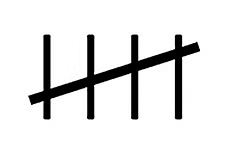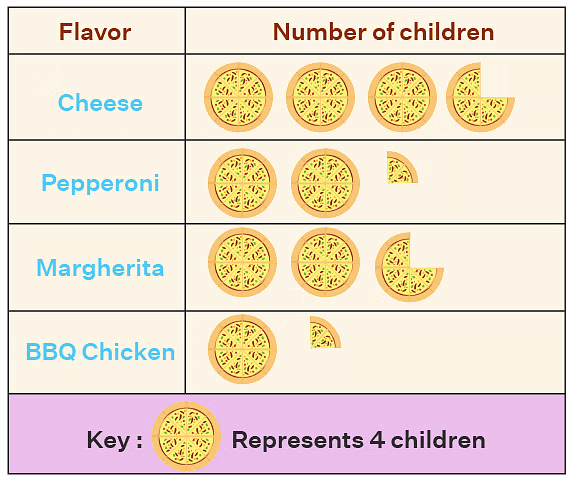Important Formulas: Data Handling and Presentation | Mathematics for Class 6 PDF Download
1. Data: Data consists of facts, numbers, measures, observations, and descriptions that provide information about various things.
2. Organizing Data: To make data easier to analyze and interpret, it can be organized into a table using tally marks.
3. Frequencies: Frequencies refer to the counts of how often specific values, measures, or observations occur.
Eg : The temperature of 7 days is recorded as 25, 24, 23, 24, 24, 21, 23. 
4. Tally Marks: These are used to show the frequency of the data.
5. Tally marks are used to count items, with each group of four vertical lines and a fifth mark as a diagonal cross representing five units.
For example, '||||' represents four, and ' ' represents five, so '
' represents five, so ' ||||' shows a total of nine.
||||' shows a total of nine.
6. Pictographs: Pictographs use pictures or objects to represent data. Each picture stands for a certain frequency, which can be one or more units.

The scale, which indicates what each picture represents, must be clearly specified.

Since we cannot draw so many pictures for a larger data, we represent the key. Key means that one image represents how much frequency. So one pizza picture represents 4 number children.
7. Bar Graphs:
- Bar graphs display data using bars of uniform width.
- The length or height of each bar shows the total frequency of occurrence for that category.
- It is essential to specify the scale that converts the length or height of the bars into actual frequencies.
- You have data on the number of books read by each friend:
Alex: 3 books, Bella: 5 books, Chris: 4 books, Dana: 2 books, Evan: 7 books, Fiona: 6 books
To visualize this data, you decide to create a bar graph. In this graph, each bar’s height will represent the number of books read by each friend. The bars will be labelled with each friend's name, and their heights will correspond to the number of books they read.
8. Choosing the Scale: Selecting an appropriate scale for pictographs or bar graphs is important. A good scale ensures that the data is represented accurately and is visually appealing.
9. How to draw a bar graph:
To track hours spent on different sports, follow these steps:
- Draw Axes: Create a horizontal line (x-axis) for sports and a vertical line (y-axis) for hours.
- Choose a Scale: Set 1 unit length on the y-axis to represent 1 hour.
- Draw Bars:
Soccer: 8 units high, Basketball: 5 units high, Tennis: 7 units high, Swimming: 6 units high
10. Why Bar Graphs Are Useful:
- Bar graphs visually represent data, making it easy to compare different categories.
- They are especially useful for handling larger amounts of data or when precision is needed.
11. Graph Design: Other design elements, such as the use of colours, accompanying pictures, and whether the bars are horizontal or vertical, contribute to how effective and visually attractive the graph is.
11. Infographics are enhanced data visualizations, such as bar graphs, with added artistic elements. They use eye-catching visuals to present information clearly and quickly, making the data both engaging and informative.
12. Data Interpretation: By accurately reading pictographs and bar graphs, we can quickly understand and draw conclusions from the data presented.
|
48 videos|334 docs|23 tests
|
FAQs on Important Formulas: Data Handling and Presentation - Mathematics for Class 6
| 1. What are some common types of data presentation techniques? |  |
| 2. How can data be organized for effective handling and presentation? |  |
| 3. What is the significance of data handling and presentation in academic exams? |  |
| 4. How can students improve their data handling and presentation skills for exams? |  |
| 5. What are some common mistakes to avoid when handling and presenting data in exams? |  |

















